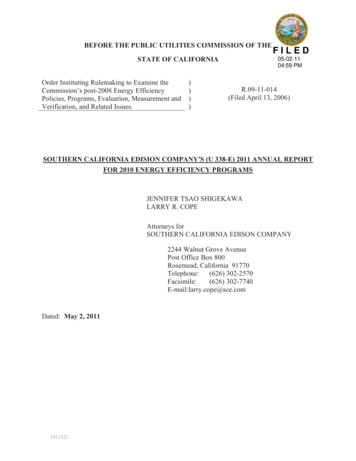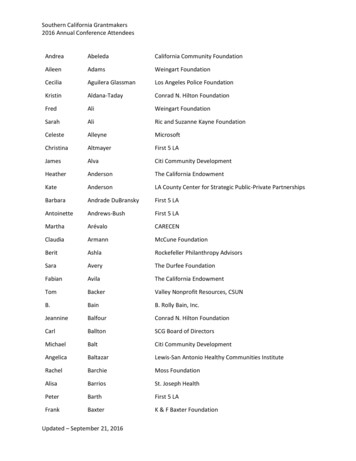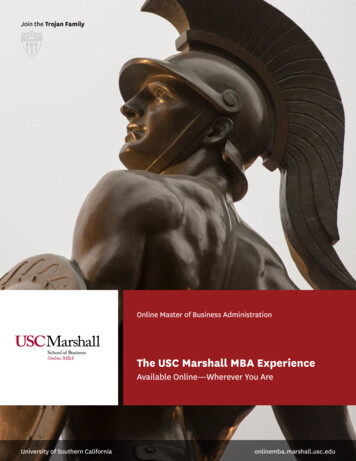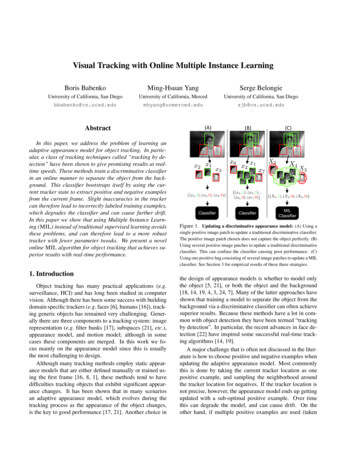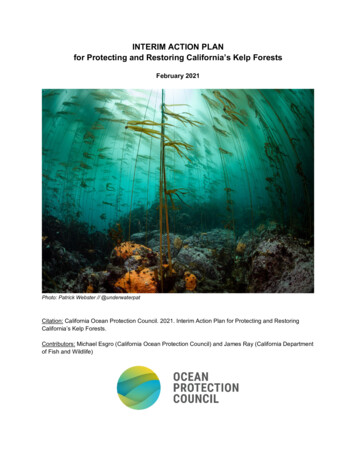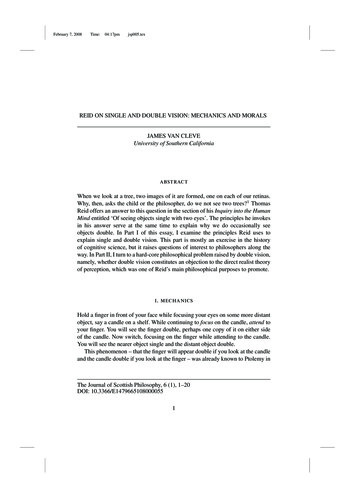
Transcription
February 7, 2008Time:04:17pmjsp005.texREID ON SINGLE AND DOUBLE VISION: MECHANICS AND MORALSJAMES VAN CLEVEUniversity of Southern CaliforniaabstractWhen we look at a tree, two images of it are formed, one on each of our retinas.Why, then, asks the child or the philosopher, do we not see two trees?1 ThomasReid offers an answer to this question in the section of his Inquiry into the HumanMind entitled ‘Of seeing objects single with two eyes’. The principles he invokesin his answer serve at the same time to explain why we do occasionally seeobjects double. In Part I of this essay, I examine the principles Reid uses toexplain single and double vision. This part is mostly an exercise in the historyof cognitive science, but it raises questions of interest to philosophers along theway. In Part II, I turn to a hard-core philosophical problem raised by double vision,namely, whether double vision constitutes an objection to the direct realist theoryof perception, which was one of Reid’s main philosophical purposes to promote.i. mechanicsHold a finger in front of your face while focusing your eyes on some more distantobject, say a candle on a shelf. While continuing to focus on the candle, attend toyour finger. You will see the finger double, perhaps one copy of it on either sideof the candle. Now switch, focusing on the finger while attending to the candle.You will see the nearer object single and the distant object double.This phenomenon – that the finger will appear double if you look at the candleand the candle double if you look at the finger – was already known to Ptolemy inThe Journal of Scottish Philosophy, 6 (1), 1–20DOI: 10.3366/E14796651080000551
February 7, 2008Time:04:17pmjsp005.texJames Van Clevethe second century. What accounts for it? Reid offers an explanation that servesto explain two related phenomena as well, giving us three explananda in all:Why do we normally see objects single despite having two retinal images ofthem? (IHM: 133; paragraphs 1 & 2)Why do we sometimes see two Xs when only one X is present? (IHM: 133;paragraph 3)Why do we sometimes see one X when two Xs are present? (IHM: 133;paragraph 8)The law of vision to which Reid appeals in answering all three questions isthe law of corresponding points. The basic idea is this: to each point of eitherretina, there is a corresponding point of the other; when rays from an objectfall on corresponding points, the object is seen as single; when they fall onnoncorresponding points, the object is seen as double.That is not quite how Reid puts it, however. He defines corresponding pointsas points of the retina the stimulation of which produces single vision:When two pictures of a small object are formed upon points of the retinae, ifthey show the object single, we shall, for the sake of perspicuity, call such twopoints of the retinae, corresponding points. (IHM: 133; emphasis added)2He then lays down as a law of nature a principle specifying which points arecorresponding:The two centers of the retinae are corresponding points; so are points ‘similarlysituate’ with respect to the centers, that is, lying at the same distance and in thesame direction from the centers. (IHM: 133; paraphrasing rather than quoting)Reid thus makes it a matter of definition that corresponding points yield singlevision and a matter of law, to be established empirically, that ‘similarly situate’points are corresponding in the sense defined. It would be possible to proceedin the opposite manner. That is, one could define corresponding points ingeometrical fashion and then let the law be that corresponding points showthe object single (that is, when light from the same part of an object falls oncorresponding points, that part is seen as single). That is the course taken byRobert Smith, a writer on optics with whose work Reid was familiar:When the optick axes [lines from the fovea through the pupil] are parallelor meet in a point, the two middle points of the retinas, or any two points2
February 7, 2008Time:04:17pmjsp005.texReid on Single and double VisionFigure 1.which are equally distant from them, and lye on the same sides of them eithertoward the right hand or left hand, or upwards or downwards, or in any obliquedirection, are called corresponding points. Now we find by experience thatan object or point of an object appears single when its pictures fall uponcorresponding points of the retinas, and double when they do not. (Smith 1738;cited in Wade 1998: 226–7)3It is merely a matter of convention which course we take. Whether formulatedReid’s way as ‘similarly situated points are corresponding points’ or Smith’s wayas ‘the stimulation of corresponding points yields single vision’, the empiricalcontent of the law is the same: the stimulation of similarly situated points yieldssingle vision.4How does the law explain the various phenomena? The first thing to beexplained is why we normally see single. One case of this is illustrated in Figure 1.Here both eyes are focused on the candle; light from the candle therefore reachesthe two foveas, which are corresponding points; the candle is therefore seen assingle.Now let us add a second candle, displaced somewhat to the right from thefirst, as in Figure 2. Rays from this candle will reach points that lie to the samedistance leftward from the fovea. These points are again corresponding points, sothe second candle will also be seen as single.5So far we have explained why we normally see single with two eyes. The nextthing to be explained is why we do sometimes see double. Figure 3 illustrateswhat happens when I focus on a candle in the background while my finger isinterposed in the foreground.3
February 7, 2008Time:04:17pmjsp005.texJames Van CleveFigure 2.Figure 3.Rays from the candle reach the two foveas, which are corresponding points, soI see the candle single, just as in Figure 1. But rays from the finger reach pointslying in opposite directions outward from the foveas, which are not correspondingpoints. The finger is therefore seen double, as attention will verify. Were I to focuson the finger instead, it would be seen as single and the candle as double. That isbecause rays from the finger would then strike the two foveas, while rays from thecandle would strike points lying in opposite directions inward from the foveas.4
February 7, 2008Time:04:17pmjsp005.texReid on Single and double VisionFigure 4.The last thing to be explained is why we sometimes see two things as one.Reid says this will happen if we view the objects through two parallel tubes, sothat each eye receives light from only one object in the pair. Reid writes,If two pieces of coin, or other bodies, of different colour, and of different figure,be properly placed in the two axes of the eyes, and at the extremities of thetubes, we shall see both the bodies in one and the same place, each as it werespread over the other, without hiding it; and the colour will be that which iscompounded of the two colours. (IHM: 136)I have satisfied myself that Reid is right. I cut out two paper disks, one blue andthe other yellow, and viewed them through cardboard tubes, one directed at eachdisk. I saw a single disk in which a dark bluish gray overlay most of the yellow,somewhat as in an eclipse of the moon.6 Figure 4 explains why.Rays from the two disks strike the foveas (corresponding points) of the twoeyes, so they are seen as if united into one. In the absence of the tubes, the eyeswould converge on one disk (say, the left one); light from the left disk would reachthe two foveas while light from the right disk reaches points similarly situatedwith respect to the foveas, as in Fig. 2. Two disks would be seen. But with thetubes in place, the two disks are separately foveated, and they are seen as one.We have now seen how the law of corresponding points explains our threeexplananda. But what explains the law itself – how are we to account for theremarkable fact that an object striking similarly situated points of the retinas isseen as single? One might naturally think that the nerve fibers proceeding from5
February 7, 2008Time:04:17pmjsp005.texJames Van Clevesimilarly situated points meet at a point further downstream, where some sort offusion of images takes place. Indeed, various thinkers offered their conjecturesabout the site of fusion: Roger Bacon suggested the optic chiasm, Descartesthe pineal gland, and Newton the sensorium. But this is the sort of thing thatReid would have declined to speculate on, given the knowledge of his day. ByNewtonian method as Reid professed it, one may legitimately explain phenomenaonly by appeal to laws reachable by induction from the phenomena themselves(or other related phenomena). Hypotheses not so reachable are mere hypotheses,unworthy of philosopher:We laugh at the Indian philosopher, who, to account for the support of the earth,contrived the hypothesis of a huge elephant, and to support the elephant, a hugetortoise. . . . His elephant was a hypothesis, and our hypotheses are elephants.(IHM: 163)Reid’s bottom line on the law of corresponding points, then, is this: ‘it must beeither a primary law of our constitution, or the consequence of some more generallaw which is not yet discovered’ (IHM: 166).There is one point about the status of the law of corresponding points, however,on which Reid does take a stand: it is a genuine law, the same for all humanbeings at all times. Single and double vision are ‘not the effect of custom, but offixed and immutable laws of nature’ (IHM: 156).7 By ‘custom’ he does not meansocial practices or conventions, but individual habits as acquired or modified byassociation. He is opposed to the view that we must learn to see objects singlewith two eyes.I think it is worth distinguishing a more and a less radical version of thecustom view. According to the less radical view, we originally see fixated objectsdouble and continue to do so until touch corrects vision. This was the view of theeighteenth-century naturalist Buffon:A second error in the vision of infants arises from the double appearance ofobjects; because a distinct image of the same object is formed on the retina ofeach eye. It is by the experience of feeling bodies only that children are enabledto correct this error. (de Buffon 1749, cited in Wade 1998: 254) 8What is the nature of the ‘correction’ to which Buffon refers? Do we continueto see double, but, knowing better, disregard our eyes and believe our hands?Or does the brain somehow change our very percepts, bringing those of sightinto agreement with those of touch so that we now genuinely see single whencorresponding points are stimulated? I do not know, but I am going to assume thatBuffon had the latter process in mind, if only to have a better foil for Reid.96
February 7, 2008Time:04:17pmjsp005.texReid on Single and double VisionThe more radical version of the ‘we see single by custom’ view holds that priorto associations with touch, there is no such thing as seeing single or double. Themore radical view says about number what Berkeley said about distance outwardin the third dimension: it is not properly a characteristic exemplified in visualfields at all. We learn by association that certain visual appearances are signs thatif we walk so far, we will feel such and such, and prior to such learning, we wouldnever dream of applying terms such as ‘near’ and ’far’ to items in our visual field.Similarly, it is only after we have learned that certain visual arrays signify thatwe shall feel one candle or two (as the case may be) that we see one candle ortwo, and our so seeing simply consists in the fact that the visual cue suggests thetangible result.Perhaps because it is analogous to the view Berkeley unequivocally holdsabout depth, Reid attributes to Berkeley the radical view about number as well.He says it is Berkeley’s opinionthat we do not originally, and previous to acquired habits, see things eithererect or inverted, of one figure or another, single or double, but learn fromexperience to judge of their tangible position, figure, and number, by certainvisible signs. (IHM: 117)As an instance of this general position,if the visible appearance of two shillings had been found connected from thebeginning with the tangible idea of one shilling, that appearance would asnaturally and readily have signified the unity of the object, as now it signifiesits duplicity. (IHM: 116)I find the more radical view incredible, but fascinating and worthy of furtherprobing.Berkeley is famous for giving an answer of no to Molyneux’s question: woulda man born blind made to see recognize by sight alone cubes and globes that hehad previously been able to recognize by touch? If Reid is right in attributing toBerkeley the radical view about number, Berkeley should also give an answer ofno to the numerical variant of Molyneux’s question: would a man born blind andmade to see recognize by sight alone single dots and pairs of dots that he hadpreviously been able to recognize (as Braille readers can) by touch? Indeed, onthe radical view, the man given sight for the first time would not even understandthe meanings of ‘one’ and ‘two’ as applied to items in his visual field.If Berkeley did indeed take the radical line about number, I would submit thefollowing objection: do you not admit that a circle is a visibly different figurefrom a figure eight? Yet what can the visible difference consist of, if not the factthat one figure contains two circles and the other only one?107
February 7, 2008Time:04:17pmjsp005.texJames Van CleveFigure 5.Reid’s own objection to the ‘custom, not nature’ view is not the one I havejust raised. He does not single out the radical line for special criticism, butraises instead an empirical objection that applies equally to the Berkeleian andBuffonian views.11 The objection is based on the following principle:It may be taken for a general rule, That things which are produced by custom,may be undone or changed by disuse, or by contrary custom. On the other hand[that is, taking the contrapositive], it is a strong argument, that an effect is notowing to custom, but to the constitution of nature, when a contrary custom,long continued, is found neither to change nor weaken it. (IHM: 154)12He then goes on to argue that in fact there are no well substantiated cases ofdouble vision giving way to single solely because of contrary custom. Repeatedlyfeeling one thing when we see two is not enough to make us eventually see one.A problem for Reid in this connection is posed by squinters – individualswhose misaligned eyes do not properly focus on the same object. If Reid is right,it appears to follow that squinters should see double all their lives, since in theircase rays from an object never fall on corresponding points (see Figure 5).Yet they do not see double all their lives, as Reid well knows.13 What gives?The answer, in a nutshell, is that Reid believes squinters become functionallyblind in one eye. The law of corresponding points implies that squinters willalways see double only in conjunction with an auxiliary assumption, namely, thatthey continue to have vision in each eye. Reid upholds the law by casting doubt onthe auxiliary assumption. He identifies various possible causes for loss of vision8
February 7, 2008Time:04:17pmjsp005.texReid on Single and double Visionin the squinting eye (for example, the line of sight from the deviant eye mightbe blocked by the nose, or habitual disregard of images received by the squintingeye might lead to what is nowadays called ‘inattentional blindness’.) He then goeson to summarize the results of his own examination of over twenty persons whosquinted, reporting that he did indeed find in each of them some defect of visionin the squinting eye (IHM: 148).Reid’s conclusion (after seven sections devoted to squinting!) is this: ‘That, byan original property of human eyes, objects painted upon the centres of the tworetinae, or upon points similarly situate with regard to the centres, appear in thesame visible place’ – that is, as single. This property ‘must be either a primarylaw of our constitution, or the consequence of some more general law which isnot yet discovered’ (IHM: 166).A question that may occur to some of Reid’s readers is this: granting that it ispart of our constitution (and not simply a matter of custom) that we see objectssingle when they stimulate corresponding points and double when they do not,why must this be a matter of unbreakable law rather than of defeasible tendency?Why could the principle of single and double vision not be modeled on Reid’sprinciple of credulity, which says that for the good of the species, children havean innate tendency to believe everything their parents and guardians tell them,but that as they grow wiser in the ways of the world, this tendency gets modifiedand weakened?14 Such a principle would imply (agreeing with Reid) that it isour original condition to see single when our two eyes are focused on one object(or double when we have squinting eyes), but it would allow (contrary to Reid)that we might alter that condition in the face of conflicting information from othersenses.The answer, I conjecture, is this: Reid’s principle of credulity is a principleabout what webelieve, while the law of corresponding points is a principle aboutwhat we perceive. Belief is typically more plastic than perception.15 The principleof credulity, though unlimited in children, is weakened as they grow older andmeet with instances of deceit and falsehood. By contrast,Let a man look at a familiar object through a polyhedron or multiplying-glassevery hour of his life, the number of visible appearances will be the same atlast as at first: nor does any number of experiments, or length of time, makethe least change. (IHM: 156)This passage highlights the fact that for Reid, perception is not (as it is for sometheorists) simply a matter of belief acquired through the senses. There must besomething other than believing that constitutes seeing, since I continue seeingtwo after I have ceased believing in two. Reid tells us that one of the essentialingredients in perception is the mental act he calls conception, and his discussionof double vision gives us reason to think that conception is not a belief-like state.9
February 7, 2008Time:04:17pmjsp005.texJames Van CleveIn my view, it is more akin to what Russell calls acquaintance – but that is anissue for another occasion.16ii. moralsWhat philosophical morals might be drawn from the phenomenon of doublevision?One moral is that we are often in some sense blind to things we are at the sametime in some sense definitely presented with. Reid writes as follows:Thus you may find a man that can say with a good conscience, that he neversaw things double all his life; yet this very man, put in the situation abovementioned, with his finger between him and the candle, and desired to attendto the appearance of the object which he does not look at, will, upon the firsttrial, see the candle double, when he looks at his finger; and his finger double,when he looks at the candle. Does he now see otherwise than he saw before?No, surely; but he now attends to what he never attended to before. The samedouble appearance of an object has been a thousand times presented to his eyebefore now; but he did not attend to it; and so it is as little an object of hisreflection and memory, as if it had never happened. (IHM: 134)Two philosophers who are otherwise admirers of Reid, Taylor and Duggan, findthis passage shocking. They call it ‘an outrage against the common sense whichit was the general purpose of his philosophy to confirm’ (Duggan & Taylor 1958:171). I think it should be regarded instead as illustrating a phenomenon thatis surprising at first, but easily accepted once several instances of it have beenpointed out: ‘that the mind may not attend to, and thereby, in some sort, notperceive objects that strike the senses’ (IHM: 135). Contemporary psychologistshave studied other instances of this phenomenon under the heading ‘inattentionalblindness’ (Mack & Rock 1998). Much more needs to be said about it, as itis matter of some delicacy to determine in what sense you are aware of theunattended item and in what sense you are not. I shall leave these matters foranother occasion, however, and pass on to a second possible moral of doublevision that looms larger for Reid’s philosophy.Reid is a champion of direct realism – the view that perception puts us indirect cognitive contact with things in the external world.17 Among his opponentson this score is Hume, who holds that the objects of perception are always minddependent images or ideas. Here is one of Hume’s arguments for the opposingview – in fact, the only argument he gives for it in the pivotal section I.iv.2 of theTreatise:When we press one eye with a finger, we immediately perceive all the objectsto become double, and one half of them to be remov’d from their common10
February 7, 2008Time:04:17pmjsp005.texReid on Single and double Visionand natural position. But as we do not attribute a continu’d existence to boththese perceptions, and as they are both of the same nature, we clearly perceive,that all our perceptions [i.e., all the things we perceive] are dependent on ourorgans, and the disposition of our nerves and animal spirits. (THN: 210–211)It is remarkable that Reid never addresses this argument. He explicitly undertakesto refute another of Hume’s arguments against direct realism (the argument inSection XII of An Enquiry into Human Understanding concerning the table thatdiminishes in apparent size as we retreat from it),18 and he was well aware ofthe phenomenon of double vision (he gives a safer and more reliable methodthan Hume does for inducing it). Yet he never takes up the question how directrealists should respond to the argument above. In the remainder of this section, Iset out the argument in step-by-step fashion and canvass possible replies on Reid’sbehalf.When you attend to your finger while focusing on something in the distance,1. You see two fingery objects.2. There are not two (existent) physical fingers before you. Therefore,3. a. You see at least one fingery thing that is not an (existent) physical finger.b. It is a mental finger – a fingery image or sense datum existing in yourmind.4. The other fingery object you see is (as Hume says) ‘of the same nature’as the mental finger (i.e., is phenomenologically just like it). Indeed, everyfinger you have ever seen is of the same nature as the mental finger5. Items that are phenomenologically just alike have the same ontologicalstatus. (Ontology recapitulates phenomenology, to echo an old slogan.)Therefore,6. Every finger you have ever seen has been a merely mental finger.Generalizing: you have never seen any objects in the physical world, butonly mental images of them.When I speak of ‘seeing’ in this argument, I mean direct seeing – being acquaintedwith the thing itself and not merely with some intermediary from which youinfer its existence.19 With ‘seeing’ so understood, the conclusion is acceptableto indirect realists, but anathema to Reid.If we wish to resist the conclusion, which step in the argument should wechallenge?We should not balk at generalizing the conclusion in step 6. There is noplausibility in the thought that direct realism fails for fingers, but manages to worksomehow for toes or tomatoes. Let us therefore look for a step to deny higher up.Step 5 in the argument is denied by the philosophers nowadays known asdisjunctivists.20 Suppose we feel compelled by the first half of the argumentto say that at least one of the things you see in a case of double vision isa mental finger. Must we therefore say that the other fingery object you see11
February 7, 2008Time:04:17pmjsp005.texJames Van Cleve(or the single fingery object in a case of single vision) is likewise a mentalobject? Disjunctivists say no. Even if everything about the experiences of twoobjects is just the same qualitatively or from the inside, that does not meanthat we must give the two experiences the same ontological assay.21 One of theexperiences may have a mental finger for its object while the other experience,though phenomenologically indistinguishable from the first, has a flesh and bloodfinger for its object. Same phenomenology, different ontology.Disjunctivism is hotly debated these days, and I cannot begin to do it justicein a paragraph or two. I will simply record here my conviction that it is not thebest way out of the predicament posed by double vision, nor Reid’s way out, andmove on.Step 4 in the argument says that the second finger in a case of doublevision is phenomenologically indistinguishable from the first. This, too, has beenchallenged. Merleau-Ponty cites a wealth of examples to show that in typical casesof hallucination, the victim is able to distinguish hallucinatory experiences fromtheir veridical counterparts. (Merleau-Ponty 1962: 334–45; especially 334 and339).22 Can we say the same about the experiences of the two fingery objects indouble vision?It does generally seem to me that one of the two fingery objects looks moresubstantial than the other. In corroboration of this, the reader may wish to try thefollowing ‘touch test’, proposed to me by Brian Glenney. Induce double visionby Reid’s method – hold up a finger and focus afar while attending near. Askyourself which finger looks more substantial; then try to touch the tip of eachfinger in turn with a pencil. I find that when I try to touch the more substantialfinger, I successfully make contact: I feel the pencil with my finger, and I seem tosee two pencils touching two fingers. But when I try to touch the less substantialfinger, I make no tangible contact, and I seem to see a pencil waving right throughthe space visually occupied by the finger. I take this to confirm that one of thefingery objects really does look more substantial than the other. If it did not, howcould I reliably produce as desired either the experience of touching a pencil to afinger or the experience of passing a pencil right through a finger?We could deny step 4, then, and insist that phenomenology does enable usto distinguish the fingers – one is flesh, the other phantom. I would be uneasy,however, if we could stop the argument nowhere but at step 4. Even if hallucinatedobjects and second objects in double vision are in fact typically less substantialor vivid than veridically seen objects, it seems to me possible that a hallucinatedobject should duplicate a perceived object in all phenomenological respects. Withsuitable adjustments in the other premises, one could still argue that the objectsof veridical perception must belong to the same ontological category as whateverobjects are needed to account for these possible cases.23Moving up in the argument, we come next to premise 3, which I have split intotwo parts. The first part, 3a (you see at least one thing that is not an existent12
February 7, 2008Time:04:17pmjsp005.texReid on Single and double Visionphysical finger), follows from 1 and 2, so it cannot be denied unless we areprepared to deny one of them as well.24 But 3b (you see at least one thing that is amental finger) does not follow from 1 and 2. There are two camps of philosopherswho would deny it, each in its own way: the American New Realists of the earlytwentieth century and some of the followers of Meinong.Step 3b says that at least one of the fingery things you see exists only inyour mind. The New Realists deny this because in their view, both of the fingeryobjects you see are externally existing physical and finger-like objects, even if atmost one of them is (or is part of) a flesh and blood finger. Their strategy is tolocate the objects some would regard as intra-mental sense data right out therein the physical world – they crowd the world with colors seen only under certainlights, shapes seen only from certain perspectives, and even the visual aspects ofthe drunkard’s pink rats. As the title of a piece by one of their exponents has it,‘The Real World is Astonishingly Rich and Complex’ (Sinclair 1973: 647–54).25They avoid being trapped behind the veil of ideas by systematically accordingto the objects of perception, even in cases of illusion or hallucination, bona fideexistence in the external world.26On one point, Reid’s views display some affinity with those of the NewRealists. He distinguishes the visible figure of an object from its real figure:[A]s the real figure of a body consists in the situation of its several parts withregard to one another, so its visible figure consists in the position of its severalparts with regard to the eye. (IHM: 96)As an example of visible figure, Reid mentions the elliptical shape of a round plateviewed obliquely (IHM: 95). Now is visible figure merely an impression or anidea in the mind? No, Reid says, for ‘it is extended in length and breadth; . . . andtherefore unless ideas and impressions are extended and figured, it cannot belongto that category’ (IHM: 98). On the contrary, ‘[T]he visible figure of bodies is areal and external object to the eye’ (IHM: 101). Perhaps, then, Reid would saythat when you see double, what you see are two visible figures, both of themexisting in the space external to the eye. If the rest of the argument goes throughunchallenged, all objects of vision would be such figures.A possible development of this position would be that visible figures aregenerally (though not always) parts of the surfaces of physical things like fingersand tables, and that one can see a finger in virtue of seeing its facing surface orsome part of it. For better or for worse, however, Reid’s views about the geometryof the visual field make this strategy unavailable to him. Reid believes that thefamiliar geometry of Euclid holds for tangible figures, but not for visible figures;for example, the tangible surface of a rectang
Here both eyes are focused on the candle; light from the candle therefore reaches the two foveas, which are corresponding points; the candle is therefore seen as single. Now let us add a second candle, displaced somewhat to the right from the first, as in Figure 2. Rays from this
